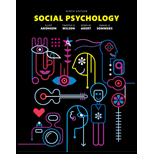
Introduction
The best response here is option (C) how his peer group behaves.
Explanation of Solution
Correct answer and explanation
Social psychology is concerned with the ways in which other people can influence our thoughts, feeling, and actions. Social psychologists are interested in understanding the characteristics of the social influence. Thus, in this case, a social psychologist can form an explanation of the young man's violent behavior by examining the influence that the behavior of his peer group has on him.
Explanations for incorrect options
Option (A), his aggressive personality traits, refers to a branch of psychology known as personality psychology. So, option (A) is incorrect.
Option (B), possible genetic contributions, refers to a branch of psychology known as behavioral genetics. So, option (B) is incorrect.
Option (D), what his father taught him, refers to a branch of psychology known as psychodynamic psychology. So, option (D) is incorrect.
Therefore, the options (A), (B), and (D) are incorrect.
Want to see more full solutions like this?
Chapter 1 Solutions
Social Psychology (9th Edition)
- 1.Explain the development of welfare programs in the 20th century and describe who the beneficiaries were and how the perception of the beneficiaries impacted public and government support for these programs?2. Discuss how the U.S. measures poverty and explain the criticisms of the method Finally, do you support a higher minimum wage than the current federal standard? Support the answer with at least two reasonsarrow_forwardProfessional goals for college students iarrow_forwardDo you think people will continue to search for their soulmate or will marriage become a thing of the last?arrow_forward
- Explain macro, micro and mezzo levels of advocacy in social work?arrow_forward3. A Recent an ethical issue you have had in your personal, professional, or volunteer experience. Discuss your decision- making process and the factors that contributed to the ultimate outcome. Please protect confidentiality and do not reveal the namems of people, communities, or organization?arrow_forward1. Describe the understanding of systematic oppression? Discuss hoiw social workers can work within society to address the issue of systematic oppression?arrow_forward
- 1. Social work is a profession committed to anti-racism, diversity, equity, and inclusion and human rights, and social raciul, economic and environmental justice. Knowing this, share how your personal, volunteer, community involvment, education, and/ or professional experiences lead you to chose social?arrow_forwardanswer two of the below questions 1. In Michael Kimmel’s TED Talk, he argues that gender equality benefits everyone, including men, while Caroline Strachan emphasizes that gender equality should not be seen solely as a women's issue. Considering these perspectives, discuss how traditional gender roles and stereotypes impact both men and women in professional and personal settings. What are some practical approaches organizations and communities can adopt to dismantle these stereotypes? How might these changes contribute to a more equitable society for all genders? 2. The readings, A Modest Manifesto for Shattering the Glass Ceiling and Women Don’t Hit a Glass Ceiling, They Hit a Broken Rung, discuss structural barriers to gender equality in the workplace, from entry-level challenges to executive leadership barriers. Analyze the effectiveness of current corporate policies in addressing these barriers and promoting equality. What additional strategies can organizations implement to…arrow_forwardThe Sierra Club work on a local or national level regarding environmental social justice?arrow_forward
- SPSS Exercises Do blacks and whites differ significantly in occupational prestige?Run a difference of means test (analyze-compare means-independent-samples T test, with PRESTG80 as the test variable and RACE groups 1 and 2 as the groups) to test the null hypothesis that race is unrelated to occupational prestige. Report the sample means and standard deviations for each group, and the appropriate test statistic for the null hypothesis. Be sure to say whether you reject or fail to reject the null hypothesis. Then, report and interpret the 95% confidence interval for the black-white difference in occupational prestige. Do men and women differ significantly in church attendance?Run a difference of means test (analyze-compare means-independent-samples T test, with ATTEND as the test variable and SEX groups 1 and 2 as the groups) to test the null hypothesis that sex is unrelated to the frequency of church attendance. Report the sample means and standard deviations for each group,…arrow_forwardTwo hundred census tracts in a city are selected at random.It is found that 100 of these tracts are serviced by a community center; the others are not. You compare the delinquency rates for these two types of tracts and obtain the following sample results: Without Center With Center Sample Size 100 100 Mean Delinquency Rate 35 25 Standard Deviation 8 6 Test the null hypothesis that there is no difference in the delinquency rates for the two types of tracts. Use a significance level of .05. From the data in problem #1, construct a 95% confidence interval around the difference in population means.Interpret your answer. For the following random samples of scores, test…arrow_forwardSummarize what learned about the strengths-based approach in practice. How does this influence, inform, or guide one's field placement activities?arrow_forward
 Social Psychology (10th Edition)SociologyISBN:9780134641287Author:Elliot Aronson, Timothy D. Wilson, Robin M. Akert, Samuel R. SommersPublisher:Pearson College Div
Social Psychology (10th Edition)SociologyISBN:9780134641287Author:Elliot Aronson, Timothy D. Wilson, Robin M. Akert, Samuel R. SommersPublisher:Pearson College Div Introduction to Sociology (Eleventh Edition)SociologyISBN:9780393639407Author:Deborah Carr, Anthony Giddens, Mitchell Duneier, Richard P. AppelbaumPublisher:W. W. Norton & Company
Introduction to Sociology (Eleventh Edition)SociologyISBN:9780393639407Author:Deborah Carr, Anthony Giddens, Mitchell Duneier, Richard P. AppelbaumPublisher:W. W. Norton & Company The Basics of Social Research (MindTap Course Lis...SociologyISBN:9781305503076Author:Earl R. BabbiePublisher:Cengage Learning
The Basics of Social Research (MindTap Course Lis...SociologyISBN:9781305503076Author:Earl R. BabbiePublisher:Cengage Learning Criminalistics: An Introduction to Forensic Scien...SociologyISBN:9780134477596Author:Saferstein, RichardPublisher:PEARSON
Criminalistics: An Introduction to Forensic Scien...SociologyISBN:9780134477596Author:Saferstein, RichardPublisher:PEARSON Sociology: A Down-to-Earth Approach (13th Edition)SociologyISBN:9780134205571Author:James M. HenslinPublisher:PEARSON
Sociology: A Down-to-Earth Approach (13th Edition)SociologyISBN:9780134205571Author:James M. HenslinPublisher:PEARSON Society: The Basics (14th Edition)SociologyISBN:9780134206325Author:John J. MacionisPublisher:PEARSON
Society: The Basics (14th Edition)SociologyISBN:9780134206325Author:John J. MacionisPublisher:PEARSON





